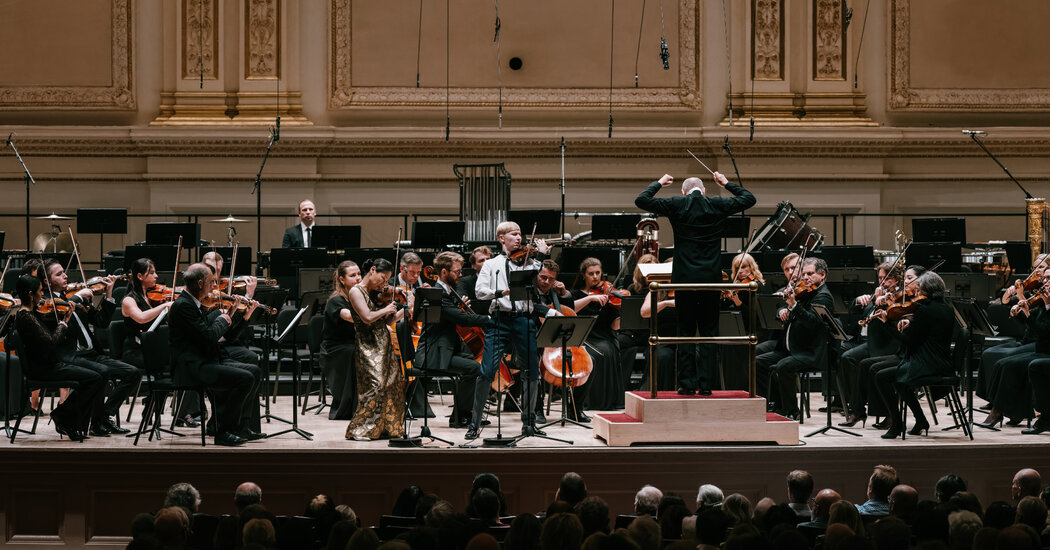Nationality has little to do with musical specialty. You don’t need to seek out a German or Austrian orchestra, for example, to hear a Beethoven symphony at its best.
The Estonian Festival Orchestra, nevertheless, is a champion of its country’s composers, like Erkki-Sven Tüür, Eduard Tubin and Jüri Reinvere. Since its founding in 2011, the ensemble has developed a broad repertoire, but its conductor, Paavo Järvi, clearly has a soft spot for his roots.
And like his father, Neeme Järvi, Paavo has dedicated himself with profound understanding and excellence to the works of Arvo Pärt: the country’s most famous composer, and the rare classical artist with pop-star recognition. He turned 90 last month, and although he is living out his twilight peacefully among the trees of a coastal forest, his birthday is being observed with concerts at home and abroad.
Including at Carnegie Hall, which named Pärt to its composer’s chair this season and brought the Estonian Festival Orchestra to North America for the first time with an expansive survey of his music. With masterly performances, starry guests and an astounding debut by the young violinist Hans Christian Aavik, it was a celebration worthy of the composer it honored.
The party continues on Friday with a concert by the Estonian Philharmonic Chamber Choir, eminent interpreters of Pärt’s music, but that ensemble also joined for bits of the orchestra’s program, which juxtaposed works from the early 1960s to the past decade: from Pärt’s years as a disciple of 12-tone modernism to the creation of his own style, a form of musical communication capable of reaching, and deeply affecting, audiences around the world.
Thursday’s concert was occasionally one of unbelievable extremes. Despite a large ensemble, including seven rows of first violins, the sound could be so quiet that it seemed to softly emerge from the walls rather than the instruments onstage. More than usual, you could hear the phones and programs that fell from seats, and it could be difficult to tell where the music ended and the distant rumble of the subway began.
Pärt’s music requires not so much restraint as focus, and Jarvi’s colleagues channeled intense expression sometimes through just a single, held note. Trusting the score, they brought “Cantus in Memoriam Benjamin Britten” to its emotional climax almost through accumulation alone, then lingered in its sea of sound before it subsided organically.
There was more of a driving power in the early “Perpetuum Mobile,” from 1963, which pulsates urgently like a countdown to apocalypse. And that alarming spirit carried into the opening of the much later “La Sindone,” drawing a connection between Pärt’s 12-tone music and his system of composing: tintinnabuli, whose rules are simple but whose results have yielded a vast range of musical thought over the past half-century.
The system can be open-ended enough to adapt with different instruments. You could make a whole album from versions of “Fratres,” which was presented at Carnegie to include most of the orchestra. The two interwoven melodic lines of tintinnabuli can movingly convey utter agony in “Sindone” but also provide, in “Swansong,” a morsel of salvation.
And sometimes, that breadth of feeling can come across within one work, like “Tabula Rasa” (1977), one of Pärt’s true masterpieces, which somehow hadn’t been performed at Carnegie until Thursday. There, as throughout the evening, the Estonians were joined by the composer Nico Muhly, moonlighting as a pianist. As one of the solo violinists, Midori had remarkable bow control for a pure, singing tone even when the music was at its most glassy and still. The other soloist, Aavik, performed with sheer energy in the first movement and entrancing calm in the second. Never forced and always thoughtful in his articulation, he is a natural Pärt interpreter.
Also naturals, and veterans, were the chorus singers. They were redolent of early music in “Adam’s Lament,” teasing out the tintinnabuli style’s natural dissonance (which is to say tension, that fundamental quality of all great art). Then they sounded thoroughly modern in “Credo,” a 1968 collage work that freely quotes from and adapts the first prelude of Bach’s “The Well-Tempered Clavier” while evoking a Mahlerian battle between light and dark.
The choir even performed in the brief encore, “Estonian Lullaby.” Disarmingly sweet, it is based on a folk tune from northeast Estonia. But here, yet again, national borders don’t mean much. Like all of Pärt’s music, it’s really for everyone.
Estonian Festival Orchestra
Performed on Thursday at Carnegie Hall, Manhattan.
Joshua Barone is an editor for The Times covering classical music and dance. He also writes criticism about classical music and opera.
The post Review: Arvo Pärt Gets the 90th Birthday Concert He Deserves appeared first on New York Times.




